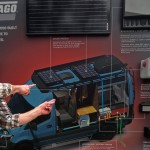This post may contain affiliate links.
If you’ve ever wondered what’s inside a lithium battery, this video is for you! When you see them on a web site, they’re all just boxes with terminals, but they’re NOT all the same inside. When we visited Lithionics Battery recently, they showed us inside their batteries, and also inside a competitor’s battery that they had taken apart as a research exercise. The result is this video:
So, I’m not a battery scientist, but I learned a few important things here.
The number of cells matters
There are a lot of ways to get to 100 amp hours at 12.8 volts. But there’s a big difference between doing it with a couple hundred tiny cells, or doing it with 12 large ones. Every cell represents a number of things that can go wrong. The connections on it may come loose; or the internal resistance of the cell can be different from its neighbors. So the fewer cells you have, the less opportunity there is for things to go wrong.
Cylindrical vs. Prismatic cells and battery heating
Any time you pack a square box with round objects, there’s going to be some wasted space. Inside a battery, that space is filled with air. That’s not bad in itself… until you want to install a heater kit on the battery. Heat traveling through air by convection is a lot less efficient than traveling directly through the battery via conduction, so the cylindrical cells are at a distinct disadvantage when it comes to heater kits.
Waste heat management
When lithium batteries are working near their limits, they generate waste heat. The best thing you can do to manage this is avoid generating heat in the first place. Since their construction has half (or less) the internal resistance of Brand B, the Lithionics batteries are only going to generate half as much (or less) heat to begin with. And once they’ve generated that heat, some batteries are designed to dissipate it faster.
There’s more in the video, but you’ll just need to watch it to get the rest. I’d actually really like to see this kind of tear-down done with more brands of batteries, but it seems like that could be an expensive video series! Sound off in the comments below and let me know what you think!











I’m able to come at this subject with an unbiased viewpoint because I’m new to RVs and don’t have brand loyalties or biases. Technology continues to improve and advance and it looks like Lithionics is part of that. Winnebago is the top name in RVs and, if they’re using Lithionics, that, to me, lends to their credibility.
The information in this video makes sense to me, especially the fewer welds equaling fewer points of failure. My question is this: If I have four Lithionics batteries, approximately how long could I run the A/C in my EKKO (which I’ll have soon)?
There’s a video for that!
There are too many variables to give a reasonable answer. But this video on a Normalized Runtime Estimate should give you an idea.
I did find that video right after I posted my comment. It made perfect sense and I appreciated learning how not to fall for sales pitches.
I have no doubt that Lithionics makes some of the very best lithium batteries in the industry. Whether they are worth nearly double the cost of Battle Born batteries is highly subjective. IMHO, reducing the number of welds is not a big benefit. The shape of the cells making for more efficient battery heating, when desired, is also not a big benefit. Generating significantly less waste heat may be of some benefit. Are all of those benefits in total worth double the cost? I don’t think so. You could get almost get two Battle Born batteries for one equivalent Lithionics battery. Is a Lithionics battery worth two Battle Born batteries? That seems like a stretch to me. But I understand that some people want what they believe to be the very best and are willing to pay for that at any price.
I’d love to do a Lithionics vs Brand B “torture test”. Of course, I’d need batteries to destroy and a way to destroy them. But I have no doubt which would melt first.
But a torture test is not a real world test. Perhaps the Lithionics batteries will last twice as long as Battle Born batteries in real world applications, but I have my doubts.
Li-Ion or LiFePO4?
LiFePO4
Lithium battery safety is a serious subject. Just ask the 37 people who died on the dive boat Conception off California a few years ago. Cheap Chinese lithium batteries are thought to be the cause of a very fast moving fire on board.
If Lithionics is going the extra mile for lithium battery safety, I’m all for it. And like everything in life, the cheapest product is rarely the safest or the most economical.
I appreciated your report from Lithionic’s factory.
Does the Boldt 70BL use same type of batteries like the Ekko?
No. The Boldt uses the Volta system. Still a lithium battery, but different from these entirely.
Bottom line, Battle Born batteries 100Ah are 900$ and Lithionium 110-120Ah are 1600$. That is a major cost difference. But I am impressed with them.
So only 80cells but it’s also designed so that if a single or a couple cells fail the battery can still be used, also they don’t generally get hot unless something is wrong at the battery level, that’s also one of the highest rated batteries, it has been tested by many many different people on YouTube and other places, this is quite biased, both are great and I have both styles and have made both styles, also I don’t see why you turn off comments on YouTube
80 cells or 100… it’s a lot more welds and potential failure points than 12.
Sure Brand B batteries are raved about on YouTube, and there are reasons for that.
Composting toilets are raved about on YouTube too. We’re the only ones that gave an accurate account of them.
In short, we think the video speaks for itself.
I don’t think repeating what a battery manufacturer is saying is “giving an accurate account”. Welds are a very well understood technology and work well in mass production so the whole idea that fewer cells is better just because of contact points does not hold water. Seems like the cars from Tesla do pretty well with many hundred contact points.
Are you actually saying that… everything else being equal… You’d prefer a battery that has MORE welds in it?
Would you prefer an engine that has more parts over one with fewer parts?
Would you also deliberately make extra splices in a wire?
Would you use 8 12 inch pipes with couplings instead of a single 8 foot piece of pipe?
Sure, welds, engines, wire splices, and plumbing connections are all well understood. And any of those scenarios can be made to work.
But any reasonable person is going to prefer something with fewer connections and points of failure.
Yes, within reason I don’t care if I have more connections if it is a highly reliable connection technology. We are not comparing a plumber making Pex connections in your basement rather industrial equipment performing laser welds. I hope you remotely understand the power of in-process controls to drive capability. In this particular case we look at 24 cells versus 80, so roughly 1:4 or approximately 1:10 if we compare, as we should, 100 Ah to 100 Ah. Ten times the number of welds means nothing if you have a capable process in contrast it would be interesting to see what the reliability of a battery cell is but I guess we talk orders of magnitude lower than a metal weld. Now if a cell fails how much capacity am I willing to loose versus carrying the 10-times higher risk of a weld failure? The concern with the number of cells does not seem very well informed but will probably and sadly resonate well with many people.
Well, you didn’t answer my question. I even bolded the important part, but you chose to ignore it. The question was ALL OTHER THINGS BEING EQUAL would you prefer more or fewer connections? No sane or reasonable person would prefer an equivalent product, but with more connections.
Regardless, yes, I think we all understand that modern laser welds can be very reliable. However, even the best weld isn’t as reliable as the one that was never made. There’s no QA for a weld that simply isn’t there.
But getting around to the overall battery construction, that brings up an interesting point. It was brought up in another comment that Brand B batteries would continue working if some cells failed. Would you rather have a battery that keeps trying to put out power, even as it falls apart? (Brand B) And why would you even design in a feature like that unless you thought it was reasonably likely your cells might fail? Or… would you rather have a battery that shuts down in an orderly way at the first confirmed failure? (Lithionics)
Look, people can get whatever kind of batteries they want. If they just want cheap batteries, Brand B are obviously the way to go. But it would be a mistake to think that the two batteries were absolutely equivalent, and that’s what I hope people take away from this video.
I answered your question right at the beginning of the response. It was a yes and I believe I am reasonably sane.
You are driving the messaging of one battery company and accuse another company of being cheap. This is odd to me and probably not helpful to the community.
Well, there’s a difference between saying “… within reason… I don’t care..” and answering what I asked. I’ll restate what I asked. You have to choose battery A or battery B. The batteries are identical in all respects except that battery A requires two perfect welds to function, and battery B requires 82 perfect welds. Which battery do you choose? The answer is one letter. Either A or B. No qualifiers. My contention is that no sane person would pick battery B.
Worth pointing out that I’m not driving the messaging of any particular company. Eliminating potential points of failure, however remote, is my own soapbox, and I believe I’m the one who brought it up. Lithionics themselves didn’t seem too hung up on this – probably because they also have a number of laser welds in their batteries (albeit a much much smaller number).
As far as Brand B batteries being cheaper… well, they are.
But I’m getting bored with this, too. Let’s just agree that you can buy whatever batteries you want and leave it at that.
Love your videos…very informative, on target and well thought out. Can’t wait to see what your battery fix will be in your new Ekko.
It’s gonna be AWESOME!
So basically brand ‘B’ uses ‘hecha in China’ rechargeable Li ‘flashlight’ type cells, spot-welded together & packaged to represent a ‘real’ battery…
Great to see this comparison that shows the quality & longevity differences…
Even we ‘non rocket scientists’ can appreciate these differences & a quality product…!
Well done & thanks to Lithionics for showing the ‘guts’ of those ‘wanta B’s’…